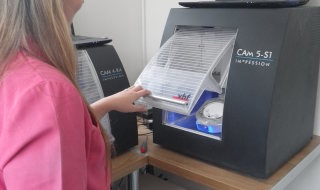
Bill Gates, former chief executive and chairman of Microsoft, suggested: ‘We always overestimate the change that will occur in the next two years, but underestimate the change that will occur in the next 10.’ So don’t be lulled into a false sense of security.
Only a few years ago the lab work received at Stephen Green Dental Studio was all analogue. Now, other than denture work, it is all digitally manufactured on CAD/CAM systems by computer savvy technicians, with a big swing towards monolithic restorations. We are also seeing an increase in the number of digital impressions being sent, which is perhaps an indication of an increasing acceptance of digital technology throughout the dental profession.
Digitisation
Whilst the motivating factors for digitisation may be cost and timesaving – I believe that ‘digital’ will soon become the standard. We only have to consider how at one time IBM was the computer giant, now it’s Microsoft. Change is constant and as professionals we need to embrace the technology that will enhance our skills and enable us to produce improved outcomes for patients. The changes that come through developing and improving technology and the associated development of materials and techniques are evident in our personal lives. How many of us would prefer 35mm film to digital photos? Or take a look at the popularity of Ebooks. Convenience and immediacy are the driving forces that are changing habits and these same forces are creating demand for a new approach in dentistry.
Costs and competition will undoubtedly drive laboratories to invest in digital technology, but what about dentists? Some say dentists are reluctant to invest as technology can be quickly superseded by the next ‘big thing’, better resolution scanners, more accurate detection of the hard and soft tissue. Quite possibly the next big thing will be the integration of the rest of the practice with CBCT (cone beam computerised tomography) scanners and database software that is secure and encrypted, such as DDX (Digital Dental Exchange).
Constant development may eventually persuade the rest to follow what is currently a slowly developing stream of activity. But there will also have to be a skills shift, for example when digital impression technology develops away from analogue and towards IT-based digital images, evaluation will be required by the dentist in real-time whilst the patient is in the chair, with the prep magnified on screen. The profession needs to have access to appropriate education in digital techniques and be prepared to take up the opportunities to learn and progress.
Materials
We are also seeing rapid improvement in the materials field, with glass ceramics and zirconia replacing metal-based restorations. Now, with the availability of faster manufacture of these materials we will see an even greater swing towards the monolithic restoration. This begs the question, why would the general person in the street pay more for the little perceived gain they might get by choosing monolithic over layered restorations? My answer is that these restorations are preferable for three reasons. First, because they use biocompatible materials, second, although they are normally used in the posterior region, they are highly aesthetic, much more so than a traditional bonded crown, and finally, the strength of a monolithic crown is far superior to that of a traditional layered build up. It is incumbent on us as dental professionals to explain these benefits and educate patients as to the most suitable restoration for their needs. By using digital techniques we are opening up a whole range of possibilities and treatment options for patients that will ultimately improve outcomes.
The perception of digitisation as being responsible for the de-skilling of a workforce is simply misplaced; we still require all our skills, and more, to work on these systems. However, we also need to appreciate that we have to be not only IT literate, but also able to use our skills on screen to design and create that which was once only possible using bunsen and brush!
Do we need IT? Yes. Digital dentistry is here now and amongst us, so embrace the present.


